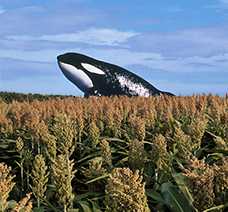Ever seen a whale in Indiana? The U.S. Environmental Protection Agency (EPA) has if you believe its recent biological evaluations on vital insecticides chlorpyrifos, diazinon and malathion. Last month I wrote about regulatory overreach and the need for farmer engagement, and I will continue the call for all hands on deck this month.
I doubt anyone at the EPA really believes whales can be found swimming through corn and soybean fields in Indiana. However, nonsense of this type is all too common in the agency’s latest biological evaluations. It is not hard to see why—the mention of whales in Indiana was buried in 12,000 pages of text and several thousand model output files.
As farmers, you were given 60 days to respond to this mountain of information that took years to compile. This illustrates the EPA’s desire to simply check a box and continue full speed toward their goal of regulating based on politics and not sound science.
Most new farm chemicals undergo testing in 100 to 200 studies before being registered as safe. The EPA has on file almost 7,000 studies on atrazine. The agency itself has reaffirmed the safety of the chemical twice since 2006, and the World Health Organization as well as the United Nations Food and Agriculture Organization agree.
If the science is on our side, why do we seem to be losing?
I looked at the staff directories and nonprofit filings for two leading critics of production agriculture and farm chemical use. Together they employ 175—including 50 lawyers—and had revenue of $23.7 million in the most recent year reports were available. Unfortunately, there are hundreds of other groups singing the same tune.
Last month I heralded the power of grassroots in the U.S. and praised you for the more than one million comments that changed the EPA’s stance on the 2014 renewable fuel standards. This month, I urge you to go one step further.
The two organizations helping leading the charge against chemical use are filled with activists. There are no bigger advocates for environmental stewardship and food security than farmers and those of us that support them. Our livelihoods require it. Unfortunately, we see politeness and activism as mutually exclusive far too often, and we let our opponents define our issues on their terms.
We can tell our story and engage EPA and others with a take-no-prisoners attitude without sacrificing our morals and values. Many of our opponents are respected members of their communities, and some even cherish the same values we do in farm country. However, when the time comes to fight for their chosen cause, they engage—professionally yet relentlessly.
Relentless is what we need from you on every regulatory battle for the next 10 years. As I write this the EPA has received 55,479 comments on their draft ecological risk assessments for triazines. Make no mistake: This is a numbers game. Many of your opponents have already weighed in on this issue and many more will weigh in before the comment period closes.
Please tell the EPA not to ignore science. Our livelihoods and U.S. food and energy security depend on you. Visit fightepa.org to learn more and make your voice heard.
Chris's columns appear in Kansas Farmer magazine monthly. You can view this column published in the online edition here.

